Microsoft Teams can have a pretty complicated licensing scheme. A Teams service plan is included in most bundles (Enterprise or Business Premium). This includes using the Teams service along with peer-to-peer calling and meetings using computer audio. You can add a Microsoft Teams Audio Conferencing license to users to expand meeting functionality with a dial-in phone number.
However, that audio conferencing license comes with limitations, especially in regards to dialing out from a meeting. This post will go through these limitations and how to avoid a potential bad end-user experience.
Microsoft Teams Audio Conferencing License
When someone schedules a meeting without a Microsoft Teams Audio Conferencing license assigned to them, the meeting invite contains a link to join the meeting. The invite does not include a dial-in number or a conference ID:

This configuration might be fine for most meetings. People can join via the web or desktop client to the meeting and use their computer audio (preferably with a Teams certified device).
However, many people want to dial into a meeting or want to have an audio-only conference bridge. To add dial-in information to a meeting invite, an administrator assigns a Microsoft Teams Audio Conferencing license to the meeting organizer.
When that person creates a Teams meeting, the invite has a toll dial-in number along with a conference ID:
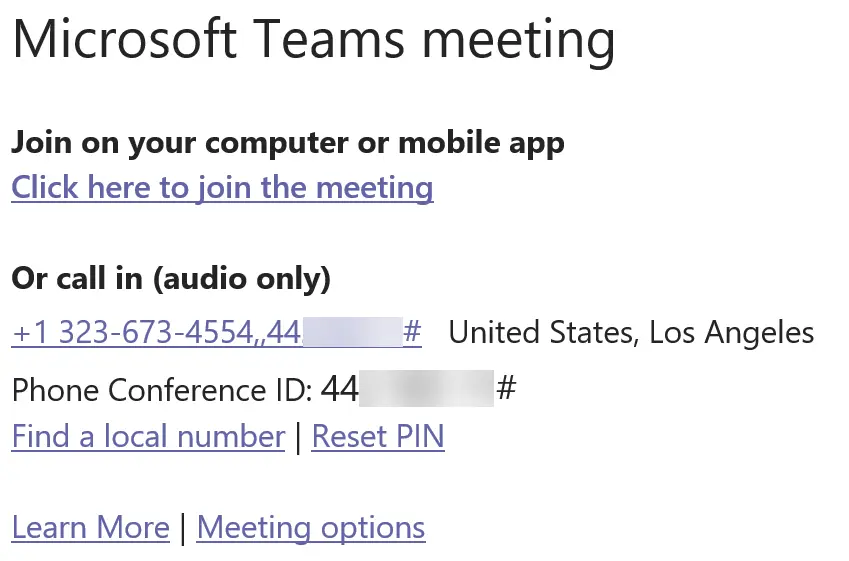
Additional options in the meeting invite include a link to find another dial-in number if the primary one is not a local number, resetting your PIN if you need to authenticate when dialing in, and configuring meeting options like lobby settings.
Joining Meetings with Microsoft Teams Audio Conferencing
To join the meeting, a person enters the dial-in conference number and enters the conference ID when prompted.
However, another option is joining the meeting from the Teams client (desktop or web) and having the meeting service call you for the audio. This is referred to as call-me-at or dialing-out from a meeting.
On the pre-join meeting screen, there is an option for Phone Audio. This option allows you to use your phone for the microphone and speaker while watching the content in the Teams client.
You do this in scenarios where you have concerns about the quality of the Internet connection. Having the Teams service dial your cell phone or landline can provide a better audio experience if your Internet connection is poor.
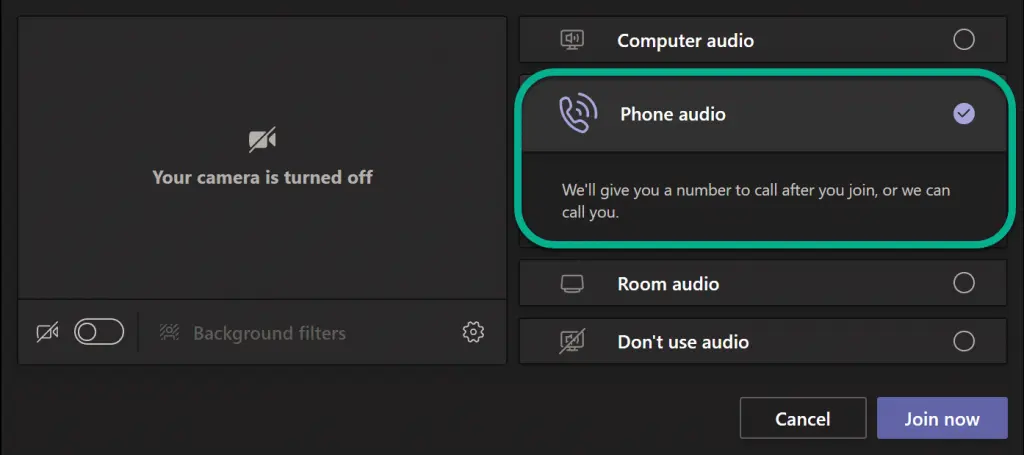
When this option is selected, you join the meeting and are prompted to enter the phone number for the Teams meeting service to dial to connect your audio:
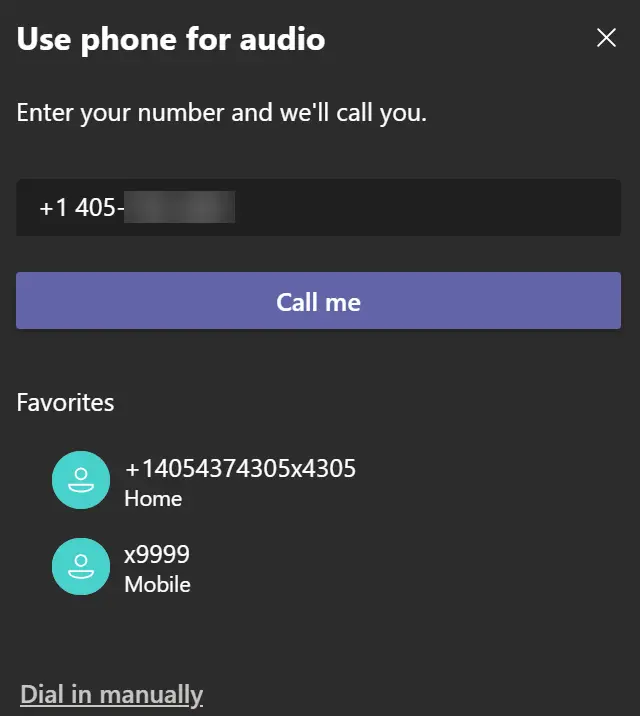
Note: Teams does perform phone number normalization does occur. Here, I entered in my 10-digit phone number and it auto-normalized to the full E.164 number with a plus sign.
The Favorites list includes recent phone numbers used for call-me-at and phone numbers configured as contact information on the Active Directory user account. The two numbers above are configured as my office and mobile phone on my user account.
Once you select Call me, the Teams meeting service will dial-out to the phone number. You answer the call and connect to the audio portion of the meeting.
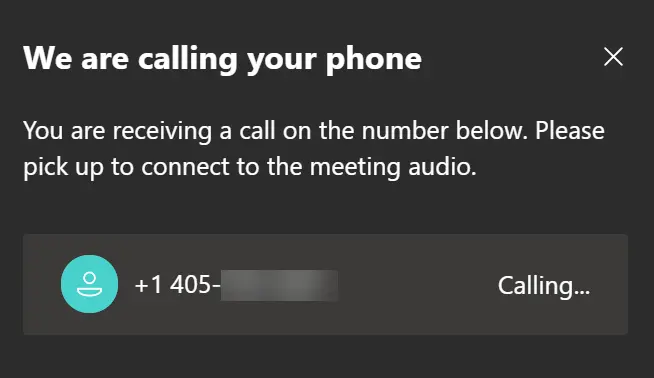
If you need to dial out after joining a meeting, select the three dots for an additional menu, then select Call me.
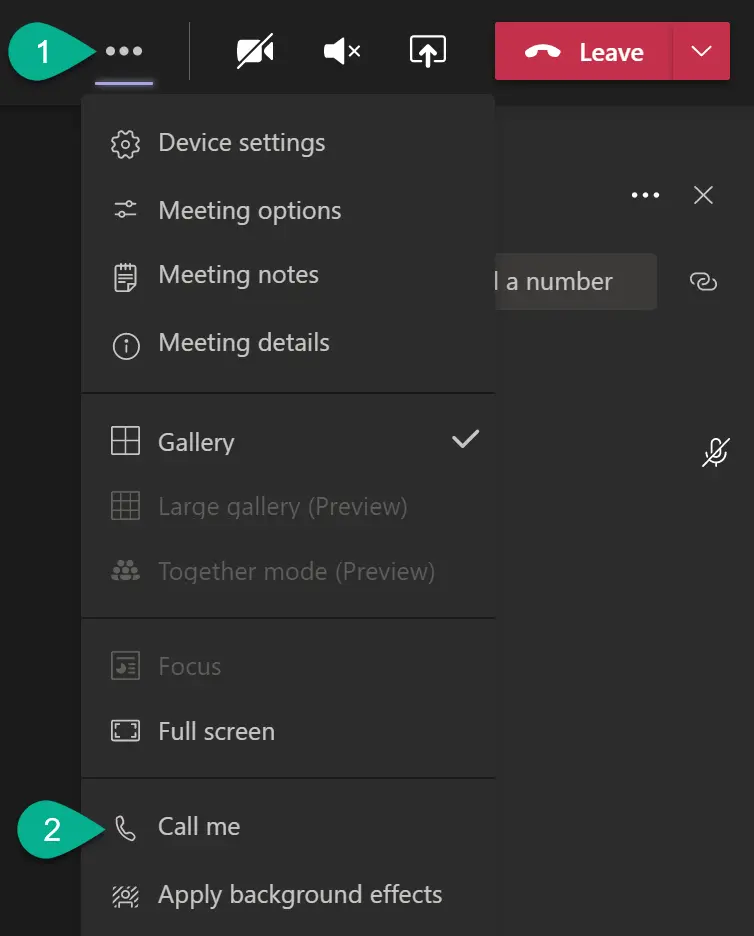
Adding Audio Only Participants to Meeting
The Microsoft Teams Audio Conferencing license enables you to add someone to a meeting by dialing their phone number. They join via their phone but do not have access to any content being presented. To dial out to add a participant, select the Participant icon, then enter the phone number to dial.
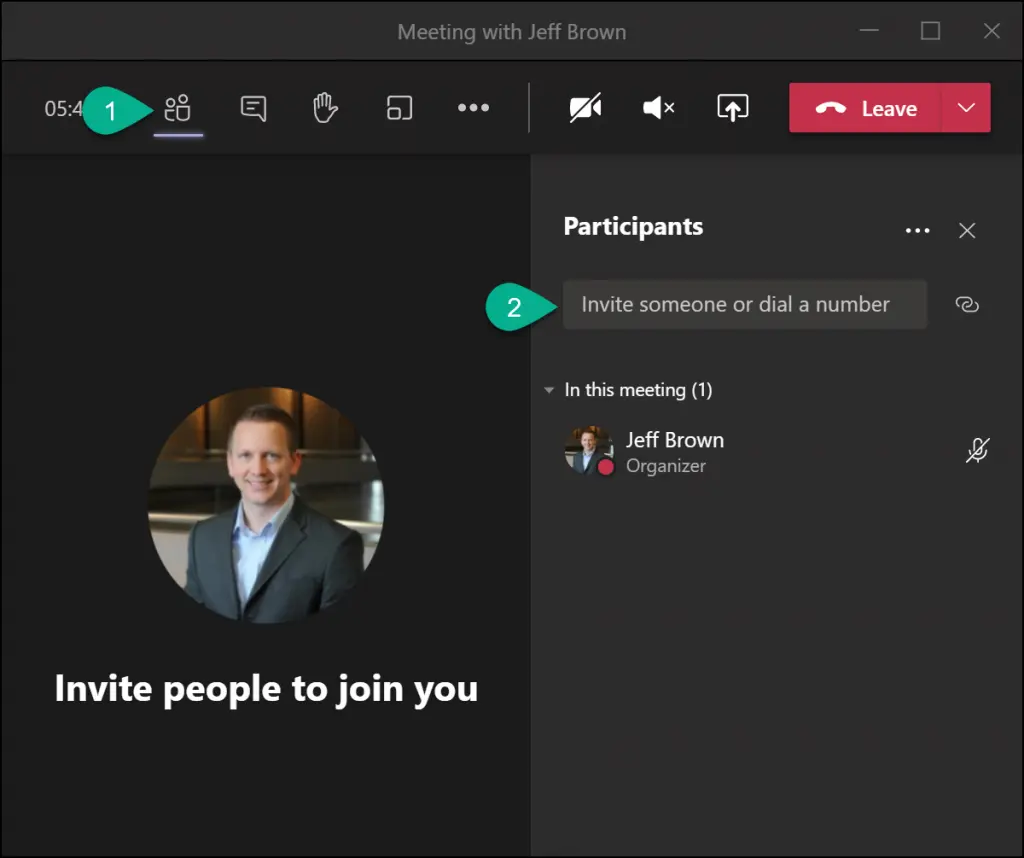
Audio Conferencing Dial-Out Limitations
Since audio conferencing became available in Teams, it had a “complimentary dial-out capability.” The benefit was for customers that were rolling out audio conferencing to their users. The benefit allowed near-unlimited calling out from meetings: 900 minutes per user per month to dial out to any of the 44 Zone A countries and regions. These minutes were pooled at the tenant level, so if you had 100 users with audio conferencing licenses, those 100 users had 90,000 minutes a month for dial out.
Unfortunately, this benefited ended on December 1, 2019. Instead of 900 minutes per user, this dropped to 60 minutes per user assigned an audio conferencing license (these minutes are still pooled at the tenant level). In our example, those 100 users drop to 6,000 minutes per month to dial out to any Zone A countries.
Also, note that the pooled minutes are for assigned licenses and not purchased licenses. The pooled minutes also only apply to monthly subscription licenses and not the pay-per-minute license.
Monitoring Audio Conferencing Dial-Out Minutes
So how can you monitor the usage of these minutes? In the Teams admin center, navigate to Analytics & reports > Usage reports, and select the PSTN minute and SMS (preview) pools. There is no date range to select as it only displays the current month’s usage, so click Run report.
This report will display the tenant’s pooled minutes for the different calling capabilities. Some examples include:
- MCOPSTN1 – Domestic calling plans
- MCOPSTN2 – Domestic and international calling plans
- MCOMEETADD – Audio conferencing
Select the MCOMEETADD option will display how many minutes are available and how many minutes have been used for the current month. Here are some examples of no minutes being used and partial minutes being used for the month.


Note: Even though I only have one audio conferencing license provisioned and assigned to my tenant, the number of available minutes jumped from 60 to 120. Not sure if this is intentional or a mistake.
Note: A limitation with this report is it only shows the current month. I’m unaware of any way to view historical reporting, so make sure you visit this report towards the end of the month to view usage before it rolls over. An alternative is to do additional analysis using the PSTN usage report, which I discuss later in this article.
Running Out of Minutes
From here, I made several calls from meetings, both using the call-me-at capability and dialing out to add a PSTN attendee to the meeting. After consuming the available pooled minutes, my report shows all the minutes being consumed:

So what happens at this point now that all my minutes have been used? When I try to have the Teams meeting service call me, I get the following message:
We could not complete the call. The user is unavailable at the moment.
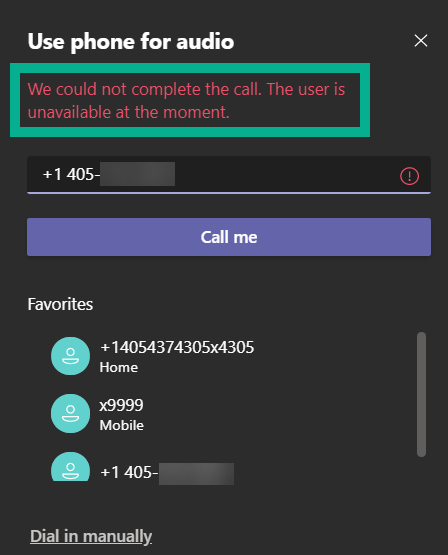
While the error message isn’t reflecting why the call failed, the failure to dial out is from the pool of minutes being completely used. Likewise, when trying to dial out to add a participant, the call shows Calling… but then silently fails without an error. Here, the error messages could be more descriptive like they were before the new meeting experience was rolled out.
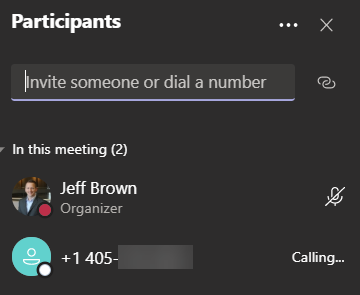
See how this might cause an issue and poor user experience? At some point during the month, your users will lose this ability and at the worse time of trying to join a meeting. They would need to fall back to using computer audio to join the meeting, often leading to poor audio quality with inadequate devices.
Viewing Depleted Minutes Report
Back in the Usage reports in the Teams admin center, change the report type drop-down menu to PSTN and SMS (preview) usage. This report shows all PSTN calls in the tenant, including conferencing dial-outs.
Want to export PSTN usage records programmatically? Check out my PowerShell module using Graph API to do so!
Select a date range and run the report. Here we see the multiple calls I made from my assigned audio conferencing bridge +1 405 666 0187 to my cell phone. Teams classifies these calls as conf_out as the call type. The sum of the durations adds up to about 120 minutes.

When I was dialing out to consume these minutes, it is a hard cutoff. When I hit the 20 minute mark of the top call record, the call disconnected. I also lost the ability to dial out. Also, note that these calls all had a $0 charge as they are consuming the tenant pooled minutes.
So how do we add back this dial-out capability once our tenant’s minutes have been consumed?
Communications Credits to the Rescue
Microsoft Teams has an additional license called communications credits that allow for purchasing additional minutes after available minutes have been consumed. Communication credits also allow the use of toll-free numbers for audio conferencing, auto attendants, or call queues.
Communications credits allow users to continue dialing out from an audio conferencing meeting once the pooled minutes are consumed. The service charges back on a per-minute basis.
To allow this consumption of the credits, you provision communications credits licenses to the tenant, which are free and unlimited. You then assign licenses to users who need to use the credit to continue making calls.
You also need to add a pre-paid balance for our credits inside the Microsoft 365 admin center under Billing > Your products. You can add funds one time or configure auto-recharge when the balance hits a certain threshold. Enabling auto-recharge ensures there is always credit available.

Note: Any funds not used within a year of purchase are forfeited, so start with small amounts and keep the recharge levels at a minimum to avoid losing them. In the example above, I have until November 4, 2020, to use the remaining $4.40 from my initial $5 purchase of credits.
Once the communications credits license is assigned, users continue making dial-out calls after the pooled minutes have been consumed. They are charged on a per-minute basis.
Tracking Communication Credit Usage
Back in the PSTN & SMS (preview) usage report, you identify calls using communications credits by seeing if they have a value in the Charge column and MCOPSTNPP in the Capability column. MCOPSTNPP is a short name for the communications credits license.
After assigning myself a communications credits license, I used the call-me-at function in a meeting. Let’s check out my updated report:

Note: I removed some of the default columns to show the portions of the report that were applicable.
Going back to the Microsoft 365 admin center under Billing > Your products, my communications credits balance has already been deducted that $0.16 charge:

Dialing Out with Calling Plans
NOTE
I have not seen this consistently happen in other customer tenants, so your mileage may vary. Using calling plans to dial out from a meeting could have been a fluke when I performed my testing above. I would not rely on Calling Plan minutes for dialing out from conferences.
While working on updating this post, I ran into a situation that I had not seen before. While testing the dial-out capabilities, I used my account with a Calling Plan license and Teams phone number assigned. When I went to dial out, my cell phone caller ID showed my personal number. I was expecting the call to come from the conference phone number assigned to the user. Once I removed the user’s phone number and Calling Plan license, dialing out from the meeting showed the conference phone number.
When viewing the PSTN Usage Report, the reason why became clear: when I had a Calling Plan assigned, it was dialing out to my mobile number as me instead of using the conference service.

The calls circled in green showed the calls were made using the MCOPSTN1 capability, or my Domestic Calling Plan. The +1 405 437 4305 number is the Teams phone number assigned to the user. This means that instead of using the Audio Conferencing minutes to make the outbound call, Teams used my Domestic Calling Plan minutes to dial out instead.
Once I removed the Teams phone number and Domestic Calling Plan from the user account, Teams went back to using the Audio Conferencing minutes from the MCOMEETADD add-on license. These calls are circled in orange coming from the conference dial-in number +1 323 673 4554. Once those minutes were exhausted, Teams used the Communications Credits circled in blue to make the outbound call.
It appears Teams will use Calling Plan minutes to make outbound calls from a conference if they are available to the user. I’m not sure if this is a new capability or something I did not experience before in the previous testing when my user account did not have a Calling Plan license assigned.
Additional Dial Out Control
If you don’t want your users dialing out from meetings at all, you configure this on a per-user basis. Inside the Teams admin center, navigate to Users and select a user with an audio conferencing license. In the Account tab for their user account, select Edit for the Audio conferencing section. Here there is a drop-down menu for dial-out permissions and the options include:
- Any destination
- In the same country or region as the organizer
- Don’t allow

Setting to Don’t allow will disable the user’s ability to dial out from a meeting, and they will have the same experience as if the tenant ran out of pooled minutes. At this point, users will need to use computer audio for joining meetings.
To make changes in bulk, use the Grant-CsDialOutPolicy command. To view available policies, use the Get-CsDialOutPolicy command. These policies are not customizable, so Microsoft has provided several pre-built ones to fit your needs.
Read more about these policies and choosing which one is right for your users:
Microsoft Docs | Outbound calling restriction policies for Audio Conferencing and user PSTN calls
Closing
Microsoft Teams can be a complicated service with many moving parts and licenses. I hope this article explains how to navigate the Microsoft Teams Audio Conferencing service as you are planning or deploying this capability in your organization.
References
Microsoft Docs: Audio Conferencing subscription “Dial-Out”/”Call Me At” minutes benefit
Microsoft Docs: Audio Conferencing complimentary dial-out period
Microsoft Docs: What are Communications Credits?
Microsoft Docs: Microsoft Teams analytics and reporting
Enjoyed this article? Check out more of my articles on Microsoft Teams by clicking here.
Questions or comments? If so, drop me a note below or find me on Twitter or LinkedIn to discuss further.